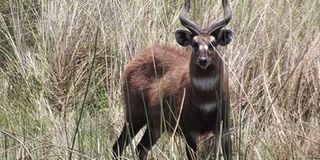Do youth hold key to conservation?

The Sitatunga is one of the endangered animals because of its meat. courtesy photo
What you need to know:
- Last year, AWF donated dogs and training to UWA and the canine unit has made 12 arrests since December.
Howard Onyuth has always had something to do with wildlife. While in Senior Two, he joined the wildlife club as one of its youngest members. He was motivated to keep wildlife; animals and plants, alive.
At university, he chose wildlife health and management as his course of study. His dream is to tell the world how important conservation of flora and fauna is to Uganda where tourism contributes 10 per cent of the Gross Domestic Product (GDP).
Onyuth was given only a minute to share his experience as a youth passionate about conservation. This was at the tail end of a presentation by Prof Lawrence Mugisha, from Makerere University department of Wildlife and an expert in wildlife health and biodiversity.
His experience prompted recollections by Dr Andrew Seguya, Uganda Wildlife Authority’s (UWA) executive director, who shared with the audience at a public lecture on March 1, in commemoration of World Wildlife Day.
“When I joined Uganda Wildlife Education Centre (UWEC) in 2006 as its ED, we looked for ways of stopping some locals in Entebbe from killing sitatungas, which live in wetlands. An idea came up that we needed to tackle the challenge by concentrating on schools. So whenever we hosted primary schools, we emphasised the importance of sitatungas. When their parents hunted them down, the children would refuse to eat the meat. Their parents soon stopped hunting sitatungas,” Dr Seguya narrated.
Youth on the rescue
His chronicle served to underscore the importance of young people in conservation, which forms the basis of the World Wildlife Day celebrations under the international theme, ‘Listen to the young voices’ and local theme that roots for mainstreaming the youth in wildlife conservation.
Dr Mugisha commended UWA’s recognition of youth as important people in wildlife business, even as it comes a bit late. But better late than never.
The wildlife enthusiast quoted figures which show that more than half of Uganda’s population consists of young people, many of them under 15 years of age.
“Worth noting is that Uganda has lost wildlife resources of up to 52 per cent between 1970 and 2014. Some animals have become extinct and some have come close to extinction which has caused an imbalance in the ecosystem,” Dr Mugisha explained.
State minister for Tourism, Godfrey Kiwanda, partly attributes the loss of wildlife to tumultuous times Uganda has gone through, particularly during the 1970s where soldiers and locals killed and traded animals in absence of observation of the law.
Dr Seguya rightly observed that human encroachment on wildlife habitats remains one of the biggest challenges to conservation, further explaining that issues that point to the fact that youth remain unemployed, uneducated and rural areas where protected areas are located, accounts for poaching and encroachment on wildlife spaces.
“Clearly if these youth are unemployed and uneducated, they will need food to eat and therefore turn to protected areas and also there is need for land for settlement and such people will encroach on wildlife spaces,” UWA’s ED further argued.
The commissioner of youth and children affairs at the Gender ministry, Francis Kyateka Mondo, while reacting to Kiwanda’s argument that conservation is expensive, says that whereas conservation is as such, it is more expensive not to conserve because tourism as a sizable income earner needs to be cherished and preserved.
“If we do not conserve, then even the flora and fauna that Sir Winston Churchill admired and christened us the Pearl of Africa will be lost. We need to jealously conserve our wildlife because it is self-marketing,” the commissioner says.
Population increase remains one of the biggest threats to wildlife. “Communities struggle and look at biodiversity as an alternative source of survival. This is more so with subsistence poaching for bush meat,” says Abiaz Rwamwiri, Africa Wildlife Foundation local communications officer.
Luring amounts
The overriding threat for African Wildlife is demand and trade in wildlife and wildlife products, especially ivory, rhino horn from international markets. The money involved is huge which lures both communities and middle men to slaughter innocent creatures and smuggle them. For instance in 2014, an audit by UWA found that 1,300 kgs of ivory worth $1.1 million (about Shs3 billion) was missing, consequently attracting the attention of President Museveni, who asked the Inspector General of Government to investigate the matter.
“The latter is hard to control locally as is an organised crime with deep network both in security, communities and international circles,” says Rwamwiri.
Much of the confiscated ivory is not necessarily from Uganda, and some of the recent culprits were from Burundi, DR Congo and Tanzania.
“Smugglers have identified and turned Uganda into a conduit because of our weak penalties and fines. Africa has suffered from the trade, lost more than half the elephants and rhinos and more,” Rwamwiri explained.
Last year, AWF donated dogs and training to UWA and the canine unit has made 12 arrests since December. The current law, the wildlife act, stipulates 12 months’ imprisonment or a fine of Shs8 million which Dr Seguya has described as small and called for bigger charges of up to Shs200 million and longer prison sentences consummate to the value of wildlife trade items like ivory and rhino horns.




